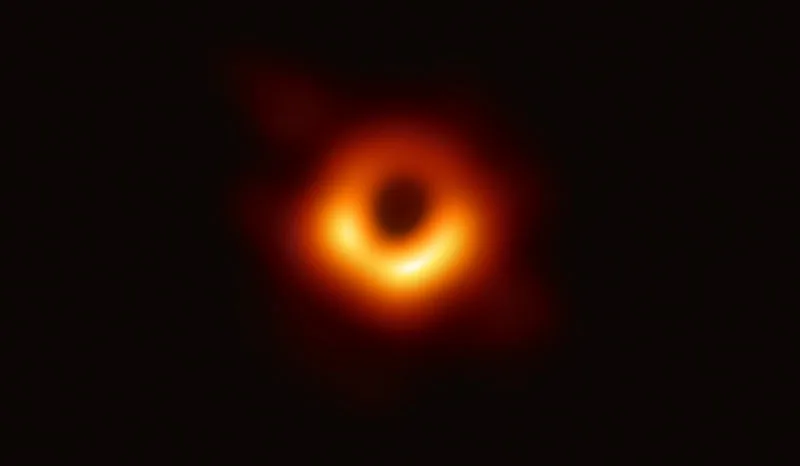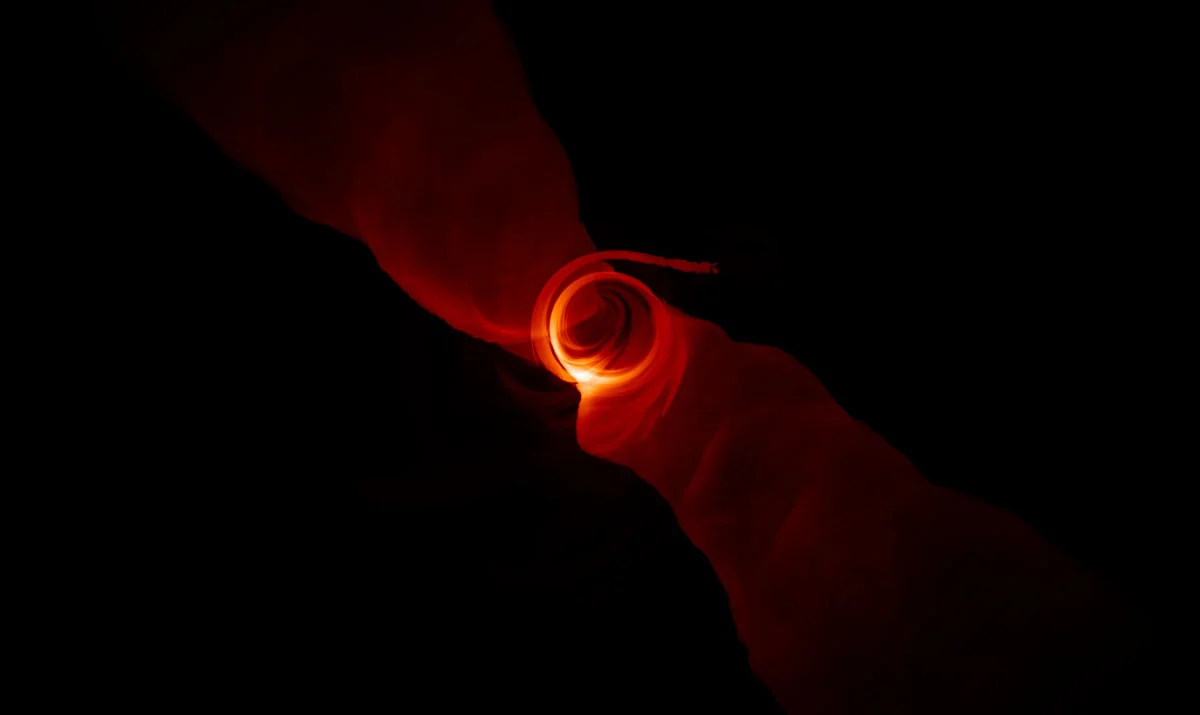
First black hole ever imaged now has an (unofficial) name
Astronomers have revealed our very first glimpse at what a real black hole looks like.
The idea behind black holes has been around now for decades. Scientists have speculated about them. They've shown up in many science fiction stories. Disney has even made a movie about one.
In all of that time, however, we have never actually seen a real picture of one.
That has now changed, as of Wednesday, April 10, when astronomers with the Event Horizon Telescope revealed the first results from their attempt to image Sagittarius A* (pronounced A-star), the supermassive black hole that lies at the centre of our Milky Way galaxy, and the supermassive black hole that lies at the core of nearby galaxy M87.
"We have taken the first picture of a black hole," EHT project director Sheperd S. Doeleman, of the Harvard Smithsonian Center for Astrophysics, said in a press release. "This is an extraordinary scientific feat accomplished by a team of more than 200 researchers."

This first-ever image of a black hole, captured using the Event Horizon Telescope, shows the supermassive black hole that lies at the centre of the galaxy M87. Credit: Event Horizon Telescope Collaboration
The image, above, released by the Event Horizon Collaboration on Wednesday morning, shows a bright ring of plasma that surrounds the black hole. This supermassive black hole is estimated as being 6.5 billion times more massive than the Sun, and is larger than our solar system.
"We have gone right to the edge of the event horizon, and seen the point of no return," said EHT researcher Avery Broderick, from the University of Waterloo's Perimeter Institute. "This is an extraordinary moment in science."
Watch below, to see the scientists, including Perimeter Institute researcher Avery Broderick, describe this discovery, in their own words.
According to the EHT press release, the dark region in the centre of the image is the shadow of the black hole, against the bright matter around it.
This shadow is the closest we can come to an image of the black hole itself, apparently. We will never see the black hole, itself, since light cannot escape its event horizon.
The black hole's boundary - the event horizon from which the EHT takes its name - is roughly 2.5 times smaller than its shadow, according to the scientists - just under 40 billion kilometres across.
"We have achieved something presumed to be impossible just a generation ago," Doeleman said. "Breakthroughs in technology, connections between the world's best radio observatories, and innovative algorithms all came together to open an entirely new window on black holes and the event horizon."
ADORNED FATHOMLESS DARK CREATION
While the imaged black hole is being called M87*, it has also been given another, still as of yet unofficial, name - Powehi.
Powehi means "the adorned fathomless dark creation" or "embellished dark source of unending creation", and originates from the Hawaiian creation chant, known as the Kumulipo.
As with all astronomical names, this one must be authorized by the International Astronomical Union (IAU) before it becomes official.
WHY M87*, AND NOT SAGITTARIUS A*?
According to the astronomers, the supermassive black hole at the centre of galaxy M87 was a far easier target to image, compared to the black hole at the core of the Milky Way. This was due to the speed at which these objects are moving, relative to the telescope's view.
As we orbit around the galactic core, our view of Sagittarius A* changes, constantly. By comparison, M87 is a nearly fixed object in our night sky, due to its extreme distance from us (roughly 53 million light years).
The astronomers likened the difference between the two to trying to take a clear picture of a toddler running around the house (Sag A*), compared to a bear lumbering along in the forest (M87). Capturing an image of the bear is FAR easier.
WHAT IS A BLACK HOLE?
Stars live finite, balanced lives. They last for billions of years, fusing lighter elements into heavier ones, and keeping themselves intact by balancing their own crushing mass with an outward push from the fusion at their core. Eventually, though, they use up their available fuel, and they die.
For our home star, The Sun, when it stops fusing hydrogen into helium at its core, the loss of the outward push causes the core to crush down into a smaller version of itself under the weight of the rest of the star's mass. The outer layers will balloon out, turning it into a red giant star, and eventually, the ramped-up solar wind streaming out from the bloated Sun will carry away those red outer layers, leaving behind only the Earth-sized core, which will then be called a 'white dwarf star'.
WATCH BELOW: JUST HOW BIG IS THE BLACK HOLE?
For one of the most massive stars, up around 20 times the mass of The Sun or bigger, something very different happens when it runs out of fuel.
There is so much mass pushing inwards on this star's core that when it loses the outward, balancing push due to fusion, the core is suddenly crushed with such force that nothing in the universe can stop it from compacting down as far as it can go. In less than the blink of an eye, it shrinks from something that could be bigger than our Sun, down to an infinitesimally small 'singularity', and the rest of the star tears itself apart in an incredible explosion known as a supernova.
Packing the immense mass of the core into something so tiny effectively breaks spacetime.
Stuff left over, or drawn in, to orbit around the singularity, in what's called the 'accretion disk', goes faster and faster and emits intense light and radiation out into space. Close in to the singularity, though, there's a point where the gravity is so strong that nothing can go fast enough to escape, not even light.
This is the 'event horizon' of a black hole.

A simulated image by the University of Arizona shows the turbulent plasma in the extreme environment around a supermassive black hole. Credit: University of Arizona.
Now, Sagittarius A* is a different beast than one of the 'stellar mass' black holes that was just described. Sag A* is a supermassive black hole, one that is 4 million times the mass of our Sun. It is thought to have formed in the same way as a stellar mass black hole, and then it just grew and grew, either by continuously gobbling up interstellar dust at the galactic core, or possibly by swallowing other stellar mass black holes, or both.

This artist's impression depicts a rapidly spinning supermassive black hole surrounded by an accretion disc. Credit: ESO, ESA/Hubble, M. Kornmesser/N. Bartmann
HOW DO WE SEE A BLACK HOLE?
The only way that astronomers have 'seen' black holes, up until now, is by a) looking at high energy particles emitted from their accretion disks, or b) from 'jets' that shoot out of their poles, or c) by how their gravity affects affect everything around them.
The main reason for this is that a black hole is very small. Even Sagittarius A* is only about 30 times the radius of our Sun. As far away as it is - over 25,000 light years away - imaging something that resides in an extreme environment like the galactic core, which doesn't directly emit light, and is small enough to easily fit within the orbit of the planet Mercury, is not easy for even our most powerful telescopes.
The only reason telescopes like Hubble are able to capture such vivid images of distant objects is that those distant objects are very large, and very bright.
For Sagittarius A*, telescopes have spotted the X-rays emitted from its accretion disk, and they've captured its effects on the stars near the galactic core, watching as these stars whip around due to the immense gravitational pull of the black hole.
Zoom in on Sagittarius A, in this video from the European Southern Observatory*
They have also watched how it affected a large gas cloud that recently swept through the galactic core.
This ESO video shows the effects of the black hole's gravity on a passing gas cloud
What we are likely going to see now, though, should be very different than these previous attempts.
THE EVENT HORIZON TELESCOPE
The Event Horizon Telescope (EHT) is an effort to link together 8 different ground-based telescopes, positioned around the world, to effectively turn them into one Earth-sized telescope. Focusing that combined telescopic power onto the galactic core (and on the core of another galaxy, known as M87), the astronomers working on this project hope to get a clear enough picture of a supermassive black hole.
The images gathered by the EHT won't be of the gravitational effects of the black hole, or of particles or radiation emitted by the accretion disk, but instead they will constitute an actual effort to see a black hole's accretion disk, and possibly even peer through that veil, to directly view the black hole's event horizon!
How would that be possible?
What Dr Mingarelli is saying here is that, in simulations, astronomers have shown that if they can get a clear enough focus on the space around the black hole, they can pick up specific wavelengths of light that are able to freely pass right through the accretion disk.
So, if they can fine-tune the telescope to only collect the light at those wavelengths, even at the incredible distances involved, they can effectively look right through the swirling matter around the event horizon, to pick up the shadow of the event horizon, silhouetted against the glow of the matter behind it.

This infographic shows a simulation of the outflow (bright red) from a black hole and the accretion disk around it, with simulated images of the three potential shapes of the event horizon's shadow. Credit: ESO/N. Bartmann/A. Broderick/C.K. Chan/D. Psaltis/F. Ozel
Sources: EHT | NASA | ESO | Perimeter Institute











